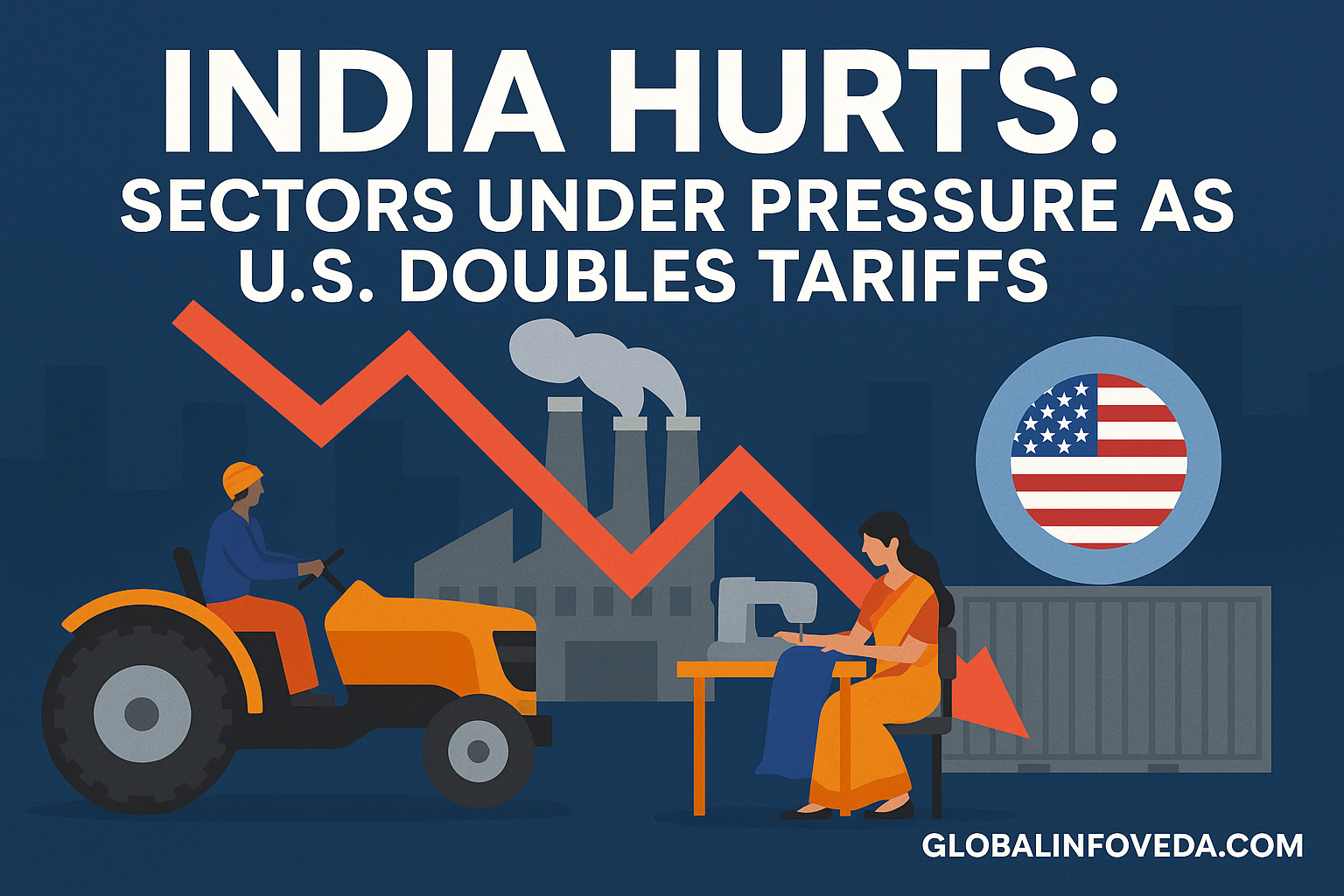Sectors Under Pressure as U.S. Doubles Tariffs
🌍 Introduction: A Jolt from Washington
In a dramatic shift in global trade dynamics, the United States has doubled tariffs on key Indian exports starting August 1st, 2025, under the new “America First Manufacturing Act (AFMA)”. The decision, framed as a national economic imperative, aims to reindustrialize the U.S. economy, reduce reliance on imports, and support local job creation.
For India, this spells trouble. The move affects $12+ billion worth of annual exports and threatens millions of jobs across manufacturing hubs in Tamil Nadu, Gujarat, Uttar Pradesh, West Bengal, and Maharashtra. Stakeholders across the spectrum—manufacturers, policymakers, MSMEs, logistics firms, and port authorities—are bracing for impact.
📊 What Changed: U.S. Tariff Policy Restructuring
| Sector | Previous Tariff (%) | New Tariff (%) | Indian Export Volume (2024) | Exporting Hubs |
|---|---|---|---|---|
| Steel & Iron | 10 | 20 | $2.1B | Jamshedpur, Bokaro, Kalinganagar |
| Textiles & Apparel | 8.5 | 17 | $3.3B | Tiruppur, Surat, Panipat, Ludhiana |
| Electronics | 5 | 12 | $2.8B | Noida, Bengaluru, Chennai |
| Solar Equipment | 15 | 30 | $1.6B | Hyderabad, Gujarat, Tamil Nadu |
| Leather & Footwear | 9 | 18 | $1.1B | Kanpur, Kolkata, Agra |
The U.S. justified this hike as a safeguard against supply chain shocks and overdependence on imports, especially post-COVID and amidst rising geopolitical tensions with China.
🇮🇳 Sector-by-Sector Fallout: India’s Internal Shockwaves
🛠️ Steel & Iron
- JSW Steel and Tata Steel have indicated shipment slowdowns.
- Margins expected to shrink by up to 20% for mid-sized exporters.
- Indian steel now priced higher than alternatives from Vietnam, South Korea, and Turkey.
👗 Textiles & Apparel
- Tiruppur and Surat garment units are operating at 65% capacity.
- Workers in spinning and dyeing units are facing mass layoffs.
- Government urged to release pending TUFS (Textile Upgradation Fund Scheme) reimbursements.
💻 Electronics
- U.S. accounts for 28% of India’s consumer electronics exports.
- Microchip packaging, PCBs, and low-cost charging units most affected.
- Expect slower growth in PLI-backed clusters like EMC 2.0 in Tamil Nadu.
☀️ Solar Equipment
- 30% tariff makes Indian solar modules costlier than Chinese by 23%.
- U.S. utility companies have paused contracts with Indian EPC providers.
- Clean energy MoUs under India-U.S. 2030 Climate Vision may face delays.
👞 Leather Goods
- Kanpur’s tanning industry already battling with environmental restrictions.
- Exporters cite 18–22% drop in new orders post-announcement.
- Increased input costs due to weak rupee compounds the crisis.
📉 Economic Ripples Across the Indian Ecosystem
- GDP Impact: Estimated 0.4% contraction in FY 2025–26 due to export drag.
- Jobs at Risk: Over 4.5 lakh jobs, mostly in MSMEs and informal sectors, under threat.
- Logistics Slowdown: Ports like Mundra, JNPT, and Chennai report container volume decline.
- Investor Sentiment: Risk premiums on Indian export-heavy stocks have risen 6–8%.
- State-Level Blow: Gujarat, Tamil Nadu, and Uttar Pradesh may see fall in tax collections.
🛡️ India’s Response Strategy in Motion
- Commerce Ministry has constituted a High-Level Tariff Mitigation Taskforce.
- WTO legal options being examined for tariff escalation breaches.
- Enhanced benefits under RoDTEP, MEIS, and SEIS proposed.
- A new Export Credit Guarantee Package to support working capital being drafted.
- Special diplomatic mission sent to Washington to reopen sectoral tariff exemptions.
- Free Trade Talks with EU, UK, Canada, and ASEAN fast-tracked with deadlines set for Q1 2026.
- Ministry of Textiles proposes a new Export Rebate Scheme for garments and home furnishings.
🔭 The Bigger Picture: Long-Term Trade Evolution
- Strategic Decoupling: Reduce India’s U.S. export share from 18% to 12% by 2027.
- Build Alternative Trade Corridors: India–Africa, Indo-Pacific, I2U2 economic corridor.
- Encourage Nearshoring: Work with UAE, Bangladesh, and Mauritius for value-chain co-production.
- R&D-Led Export Push: In sectors like green hydrogen, semiconductors, and quantum computing.
- Incentivize Product Diversification: Policies encouraging sunrise sectors like aerospace parts, medtech, agritech exports.
📣 Ground Reality: Voices from Affected Clusters
- “We’ve dropped from 120 machines running to 68 in 3 weeks. Buyers want discounts we can’t afford.” — Apparel Manufacturer, Tiruppur
- “We were planning a 1 MW solar deal in Florida. The tariff spike killed it.” — Solar Panel Exporter, Hyderabad
- “If the U.S. closes doors, we’re now betting big on German OEMs and Dubai retailers.” — Leather Goods Exporter, Kanpur
- “This tariff bombshell has led to buyer exits overnight. We need transitional funding to survive.” — Electronics SME Owner, Noida
📌 Final Insight
The U.S. tariff escalation is not just a trade disruption, but a stress test for India’s export resilience. It calls for a redefinition of India’s global trade strategy—from overdependence to diversification, from volume to value, from reactive to proactive diplomacy.
If tackled wisely, this crisis could trigger a wave of deep structural reforms, smarter FTAs, and robust manufacturing policies—transforming India’s export ecosystem for the decade ahead.
🔗 For sectoral updates, tariff tracking, and economic insights, visit GlobalInfoVeda.com
